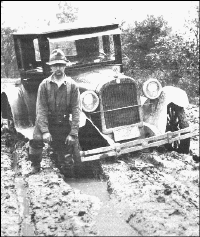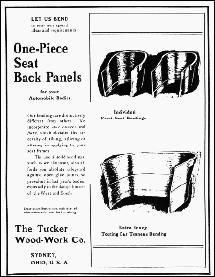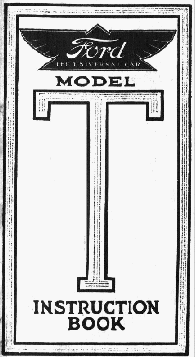Sock and Buskin's production of 'Camping with Henry and Tom'
directed by Sherrie Casad-Lodge promises to bring
back many vivid memories of the early automobiling days for those attending the show and
viewing the Shelby County Historical Society’s transportation exhibits. The play
coincides with national publicity concerning the 100th anniversary of the invention of the
automobile. The Ford Model T that is a centerpiece of the play evokes images of an era of
romance and adventure for many Shelby Countians. show and
viewing the Shelby County Historical Society’s transportation exhibits. The play
coincides with national publicity concerning the 100th anniversary of the invention of the
automobile. The Ford Model T that is a centerpiece of the play evokes images of an era of
romance and adventure for many Shelby Countians.
Certainly no other product has so revolutionized our lives. It is quite difficult to
imagine life with horses as the only source of transportation, let alone the magnitude of
the transition from the horse-drawn to the motorized era. As people, we adapted to the
automobile, and as a community, we made more than our share of contributions to this
fabulous new industry. This story will provide a glimpse of the early days of the auto in
our county. As the industrial hub of the county and all of west-central Ohio, Sidney has
always been on the cusp of industrial change. That was certainly the case in the
transportation business. Several large manufacturers in town produced wagons and buggies.
Piper Wagon Works and the Rupert Wagon Shop were established in 1847 and 1850,
respectively. James Crozier, later partnering with his son, made a high quality buggy here
for almost 60 years, beginning in 1860. The firm of Miller and Smith rounded out the list
of buggy manufacturers. Thomas Miller of
that firm would later play a key role in a dark chapter of Sidney's auto business.
Another notable buggy and carriage maker in the early days was the Bimel Buggy Company.
Former St. Marys resident  Lorenzo Bimel built a plant at 218 South Ohio Avenue, and
produced several models, including the 'Storm King' which provided the occupants
protection from the winter winds. Much more would be heard about the name 'Bimel' in the
horseless carriage days that would follow. Along with the thriving buggy business, Sidney
was the home for several companies that produced the necessary vehicle accessories. The
Underwood Whip Company was the largest manufacturer of buggy whips west of Massachusetts. Lorenzo Bimel built a plant at 218 South Ohio Avenue, and
produced several models, including the 'Storm King' which provided the occupants
protection from the winter winds. Much more would be heard about the name 'Bimel' in the
horseless carriage days that would follow. Along with the thriving buggy business, Sidney
was the home for several companies that produced the necessary vehicle accessories. The
Underwood Whip Company was the largest manufacturer of buggy whips west of Massachusetts.
Jonathan Dann operated a spoke and wheel business on Ohio
Avenue. Enoch Anderson, J. N. Anderson and Cyrus Frazier formed Anderson-Frazier Wheel
Works in 1881 to make wooden wheels and wheel parts.
One local company that made a successful transition to the automobile industry was the
Tucker Wood-Work Company.
J. B. Tucker moved to town in 1901, bought the assets of John Loughlin's school furniture business, and
began to make wooden bicycle rims. After the advent of the automobile, he converted part
of the plant to produce wooden steering wheels and auto frames for cars. In 1915, the
company produced 75,000 steering wheels. Quaintly, the company noted it was located in
"Sydney, Ohio,
U.S.A."
After the abrupt death of Mr. Tucker, Edward Mull took over the business. He was
previously employed by the Willys-Overland Company, where he was responsible for
assembling the first Overland vehicle for the firm. He renamed Tucker's business the Mull
Wood Work Company. His operation grew rapidly, becoming the second largest maker of wooden
steering wheels in the country.
History unfortunately does not record the reaction of our county residents when the
first noisy, smoke-belching, horseless carriage rolled slowly down the streets. It
must have been greeted with laughter and a bit of derision. The author of Ohio People
and Transportation recalled: "For a decade, the automobile was more to be
jeered than cheered...a rich man's plaything that scared horses, belched smoke and often
broke down.
Locally, it is believed the honor of
purchasing the first car went to George Haslup. The manager of Sidney's water works
purchased a Pope-Toledo Steamer in 1903. The vehicle was steam powered. The steam was
produced by a gasoline fired flush-tube boiler located under the front seat. Monarch
employee Daniel Toy bought it a few years later.
The shape of the first automobiles was
derived directly from the horse drawn vehicle and offered no protection from the elements,
as they did not have windshields. Sidney drivers, including Dan Toy, wore an apron which
covered their body and offered some protection from the weather. Protection was also
needed from a peril of another sort. Ann Sayre Fazzini recalls riding with her
tobacco-chewing grandfather in an open car: "There was the rush for seats which
were not in the probable trajectory of Gramp's tobacco juice." 'Closed cars', as
they were first known, which provided a closed-up interior, were not common until the mid
1920s. Early ‘covered’ models were ungainly, expensive and top heavy. In 1925,
the closed car outsold the open vehicles.
Very common, however, were Fords. By 1919, almost half of the cars in America were
Fords, or 'universal cars', as they were called. Locally, the first Ford dealership was
situated at Fair Avenue and Walnut Street, where Yendis Furniture was located. The Ford
tradition is now carried on by Sidney Ford-Lincoln-Mercury automotive dealership, a
sponsor of "Camping With Henry & Tom."
Perhaps the first auto dealer in the county was F. A. Wentz of Anna, who opened up a
dealership in 1914. One of the oldest gas stations in the nation is now owned by York's
Auto Repair. It is located at the corner of Poplar Street and Walnut Avenue in Sidney.
In an interview given in 1953, Daniel Toy recalled operating the Pope-Toledo Steamer.
Because there were no gas stations, he had to carry cans of gas and water with him.
Passing horses and buggies proved to be interesting. The law required the motorist to pull
over, if signaled, get out, and lead the horse past the noisy vehicle. A November, 1953,
issue of Monarch's Shop Talk magazine reported the experience of one driver: A
motorist was stopped one day by the violent wigwagging of an elderly lady seated in a
buggy next to the male driver. "You want me to get your horse by for you?"
the motorist called out. "No, no!" the old man answered. "You get
maw by. I'll have no trouble with the horse."
County and city roadways alike were not made for autos. Usually mud-covered and filled
with holes, they made even the shortest of drives an exciting and sometimes lengthy
adventure. R. C. Davis, a Jackson Center resident, told of a trip he took to Dayton. It
took a full day to get there and a day to return. Davis took six spare tires with him, and
used four before he arrived home. Apparently, auto pioneer Albert Pipe agreed. He once
remarked: "The American who buys an automobile finds himself with this great
difficulty: he has nowhere to use it!" Bicycle-style tires were first adapted for
use with cars, but keeping the required sixty pounds of pressure in them proved very
difficult. The most common problem was constant flat tires. Dan Toy recalled filling the
hole with rubber bands and adding a little cement. The creation of more durable balloon
tires by Harvey Firestone in 1923 helped immensely.
After Henry Ford perfected the techniques of
mass production that made the automobile affordable to a larger portion of the population,
many people began to consider the possibility of owning such a machine. Interesting
purchase considerations were included in a brochure titled 'Automobiles of 1904.' The
reader was cautioned: "Do not purchase a machine because of its speeding
ability." The author noted that there were no traffic deaths in the entire
country between 1895 and 1900, when the desire for speed first developed.
The
prospective buyer was also warned that: "The weak point of the gasoline machine is
the mechanism which produces the spark necessary... A certain amount of muscular effort is
necessary in the 'cranking' or turning the wheel which starts the gasoline engine." Anita Ditmer of Sidney remembers her father cranking the starter on their Ford Model T.
"When my dad cranked it, it would kick back. Less fortunate people suffered broken
arms." Charles Kettering of Dayton developed the self-starter in 1911. Virtually
every new car maker had abandoned the crank starter by 1916 except for Henry Ford and his
Model Ts. He must have been a brilliant, but stubborn man. Stubborn but also practical.
Henry Ford actually said that "Any customer can have a car painted any color he
wants so long as it is black." Ford knew that black paint dried the fastest. As
the sales of cars exploded after about 1910, the time consuming painting process became
the biggest bottleneck in production. After the introduction of a new lacquer by Dupont
Chemical in 1923, drying time was reduced from one week to hours.
During Sidney's own 'industrial revolution" in the 1890s, when local leaders
aggressively sought to attract businesses from other areas to move here, William Bimel,
who had taken over the Bimel Buggy Company from his father, was contacted. He agreed to
relocate from St. Marys to a just-completed structure on Miami Avenue south of the canal
feeder in 1897. He re-established Bimel's good name in the transportation business. The
horseless carriage quickly outstripped horses in popularity, and Bimel's buggy business
faded from Sidney's scene with Crozier, Miller and Smith, and the rest. The name 'Bimel',
however, would rise again.
Local industrialist and community leader W. H.
C. Goode, of course, noticed the trend, and decided to enter the auto business. He
purchased the assets of the defunct Bimel Buggy Company with a group of local investors,
and the Sidney's only venture into the automobile business was born. Thomas Miller of
Miller and Smith joined the management team. After starting operations manufacturing auto
parts in February of 1915, company officials decided to make their own machine. The rights
to a vehicle were purchased from the Elwood Iron Works in Elwood, Indiana.
This four cylinder, 30 horse powered gasoline vehicle was known initially as the 'Elco
30'. It sold for $500, and was equipped with electric lights, starter and horn, and an
ignition system. Ads boasted a 'one man top', and a frame hung on 'semi-elliptic springs'.
The Elco 30 seated five people. Almost three hundred cars were produced in 1915, with
deliveries as far away as Cuba. Another local concern, the Sidney Manufacturing Company,
produced bodies for the cars. Times were good in Sidney!
The next year the company changed its name to
the Bimel Automobile Company, began limited production of a six cylinder vehicle, and
changed the name of the 'Elco 30' to the 'Bimel 4'. Sidney resident George Bayley gave the
company some unexpected publicity on March 30, 1915. While test driving an Elco 30 for
some out of town visitors, he was arrested for speeding. The headline in the "Sidney
Daily News" read: "CHARGED WITH EXCEEDING SPEED LIMIT." Unfortunately for
the company, its troubles with the law were just beginning.
By the end of the next year,
the company began experiencing financial problems. The firm needed cash, and the board of
directors decided to sell stock to local investors. Bimel's general manager, Thomas
Miller, paid a visit to many prospective investors, including Turtle Creek residents Anna
and Ethel Jelley on December 28, 1916. Anna later testified Miller told her "The
company has no debts," that Bimel "was a safe place to invest your money"
and that "It was better than a bank." Cars cost only $35 to build, and
the rest "...was clear profit." The sisters bought $2,000 of Bimel stock.
Within six weeks of the Jelley sale, the Bimel Automobile Company was taken over by a
receiver. Its debts totaled over $175,000 and its assets did not exceed $50,000. The
company's assets were sold in May of 1917 for $15,000.
The indictment of Miller for fraud rocked the community. Not only a respected
businessman, he was a pillar of the Methodist Church and a five year
member of the Sidney Board of Education. The trial, held in December of 1917, was one of
the most widely publicized in Sidney's history. Prosecuting attorney Mills was pitted
against local attorneys Wicoff and Emmons, who defended Miller. Embarrassed company
officials including W. H. C. Goode and E. J. Griffis were subpoenaed to
testify. Lima Judge Klinger was assigned the case. The trial went on for two weeks.
The jury found Miller guilty. Judge Klinger
sentenced him to three years in prison, but then shocked the crowded courtroom and
infuriated the prosecutor by giving Miller an immediate parole. Miller moved out of town.
Thus ended the saga of the Bimel automobile in Sidney.
Sidney's role in the automobile
business was headed for happier days, however. The October 24, 1923, edition of the Sidney
Daily News carried the headline: "New Manufacturing Plant Organized."
Local industrial heavyweights L. M.
Studevant, A. J. Hess, E. J. Griffis, W. P. Anderson and Frank Thedieck took over the
assets of the  Sidney Mfg. Company and formed Anderson Body Company. The business
manufactured auto, hearse and bus bodies of wood and metal. It was located at the corner
of East Avenue and Short Clinton Street. This company helped Sidney make a lasting mark on
the automobile industry. Sidney Mfg. Company and formed Anderson Body Company. The business
manufactured auto, hearse and bus bodies of wood and metal. It was located at the corner
of East Avenue and Short Clinton Street. This company helped Sidney make a lasting mark on
the automobile industry.
Gathering experienced employees from the Sidney Manufacturing and the Mutual Wood Work
Company, Anderson Body was an immediate success. It had secured an order for hundreds of
the Anderson 'brougham' bodies from Dodge Brothers in Detroit within six weeks. By
Christmas of 1923, Anderson was running day and night.
Longtime employees Robert Van Horn and Vernal Eiler recalled their experiences in a Daily
News article on June 26, 1975. "We made more Dodges than anything else...We
made so damn many different ones I can't remember them all, but Dodges were the biggest,"
recalled Mr. Van Horn. Knowing a good thing when he saw one, he left his previous job as a
buggy seat maker to work for Anderson. Mr. Van Eiler was a door hanger with Mutual, but
quit to work on the construction of the Big
Four Bridge. After nearly falling off the structure, he accepted work as a door hanger
at Anderson. "The Dodge body was the first closed car I ever worked on. They paid
us at the rate of $7 per car, and we could do one or two a day," Mr. Eiler
remembered.
The Anderson brougham body was a hit at the 1924 New York and Chicago auto shows. It
was acclaimed as "The best designed four-passenger four-door brougham car at
either show." After the wooden frame was built, metal panels were fastened on
with nails or screws. Eventually, Finnish immigrants were brought in to operate special
electric hammers which were used to shape the metal. Peak production was ten car bodies a
day.
Anderson also made many styles of bodies for the Hudson and Studebaker vehicles.
Several of these are still in existence today. One Studebaker model had a golf bag door on
the right side! Toward the end of the 1920s, Anderson's fortunes foundered. Some Detroit
auto makers started making their own car bodies. Locally, the problems were worse. One of
the founders of the company, and its namesake, W. P. Anderson, left to form his own
business, the Pioneer Body Company. It was located at 421 Park Street. Pioneer Body
competed directly with Anderson, making car bodies for Hudson, Studebaker and Dodge
Brothers.
By 1932, local investor C. D. Beck had taken over the plant and its assets and formed
the Beck Bus Company. Mr. Beck produced bus bodies and fire trucks. He eventually moved to
a new location on Russell Rd., where CompAir Leroi is now located.
Fred D. Clark of Sidney was a financial
backer of the new Bremac Motor Car Corporation in 1932. The project was a radical new idea
in automobile construction. The Bremac had no chassis frame and, as described by the
company, seating in the five-passenger sedan was the reverse of the usual, three
passengers in front, two in the rear. In mid-October, 1932, Bremac announced that its
first prototype was under construction in Sidney — and that the company expected to
complete three cars of different model body design for exhibition at the New York
Automobile Show the following month. It never made it to show.
[ Back to Transportation Index ] |

